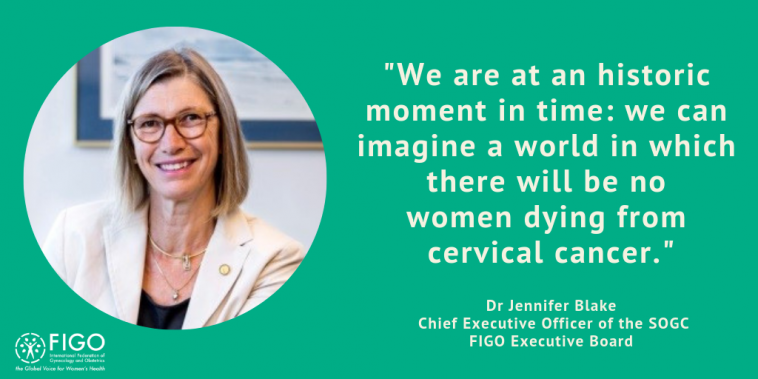Think Equal: women's health, Canada

Well-being is not just the absence of illness and injury.
Gender equality, with investment in gender-responsive services and infrastructure that meets the needs of women and girls, is essential for a world where all women achieve the highest possible standards of physical, mental, reproductive and sexual health throughout their lives.
As the global voice for women’s health, FIGO believes that the challenges women face – in their choices, pathologies, and safety – cannot be solved in clinical isolation.
We asked Dr Jennifer Blake, Chief Executive Officer of the SOGC (Society of Obstetricians and Gynaecologists of Canada) about the barriers she sees to equal access of public services and sustainable infrastructure in Canada, and innovations that are raising the status of women.
The theme of International Women’s Day this year is ‘Think equal, build smart, innovate for change.’ What does this mean to you in the context of women’s health?
Oftentimes we do not see the inequalities of our lives, or accept that ‘this is just the way it is.’ This sets the stage for accepting inequality: the first step is thinking equal. It is only when we imagine what our lives might look like if we did have equal opportunities that we can begin to see the gaps.
With gender disaggregated data analysis and reporting, women can question why gender inequalities exist, and build smarter systems to address the fundamental sources.
Innovations need not be large to be impactful: in Canada, making it a violation to ask a job applicant to supply a photograph, or ask about intentions to start a family, took down barriers and enabled more women to enter the workplace.
In women’s health a key driver of quality has been women themselves, insisting on their right to control their own sexual and reproductive health.
How is SOGC working to advance gender equity when it comes to access to public services?
The second step in taking charge of your health is to be well informed, so the SOGC over the past many years has committed to creating universally accessible educational resources for women. Starting with sexual health and education, we now reach millions of women each year through our websites SexAndU.ca, PregnancyInfo.ca, YourPeriod.ca, and Menopauseandu.ca.
We seek to be the trusted source of reliable and up to date information.
OBGYNs are on the frontline of women’s health, and change. What is the most exciting innovation you have seen when it comes to accelerating progress for gender equality in your field?
I have seen three major changes in obstetrics and gynaecology.
First was the women’s movement, and the insistence of women that they be listened to in how healthcare is delivered. Second has been the feminisation of the specialty. Third, the 180 degree shift that I have seen in Canada with respect to maternity leave.
We have gone from a speciality where a resident falling pregnant was a problem - for her colleagues who had to cover the work, and for her, having to rush back to practice as soon as possible. We now encourage our residents to plan for pregnancy, and to have their pregnancies when it is best for them. Our annual parties are now family affairs.
Can you share a story – a patient, or a clinical experience – that illustrates why healthcare systems need to respond more directly to the specific healthcare needs of women and girls?
We are at an historic moment in time: we can imagine a world in which there will be no women dying from cervical cancer.
This possibility has come about in the span of just over a decade, thanks to bold thinking, good research, innovative technology, and public policy that enabled population-wide vaccination.
And yet last week, I had a 36-year-old mother in my office with an advanced aggressive cervical cancer. In a country that offers universal health care, school based vaccination and cervical cancer screening, she was either not aware, or could not afford vaccination.
Would self-testing have enabled her to catch it earlier? Would she have chosen to pay for vaccination, or for molecular testing? Her cervical cancer is not well-detected on cytology, but Canada has not yet switched to HPV testing. In hindsight it is hard to know, but her cancer could have been prevented.
All systems are based on meeting the needs of the population as a whole, but with this we miss some women. I draw hope from the policy discussions that are now going on that challenge us to improve on vaccination rates, improve screening methods, introduce self-testing, and reach out to the hardest to reach and most vulnerable women. If we are going to eliminate cervical cancer, we know what to do. It is time now to build the smart system that will enable that outcome, and innovate to bring everyone along.